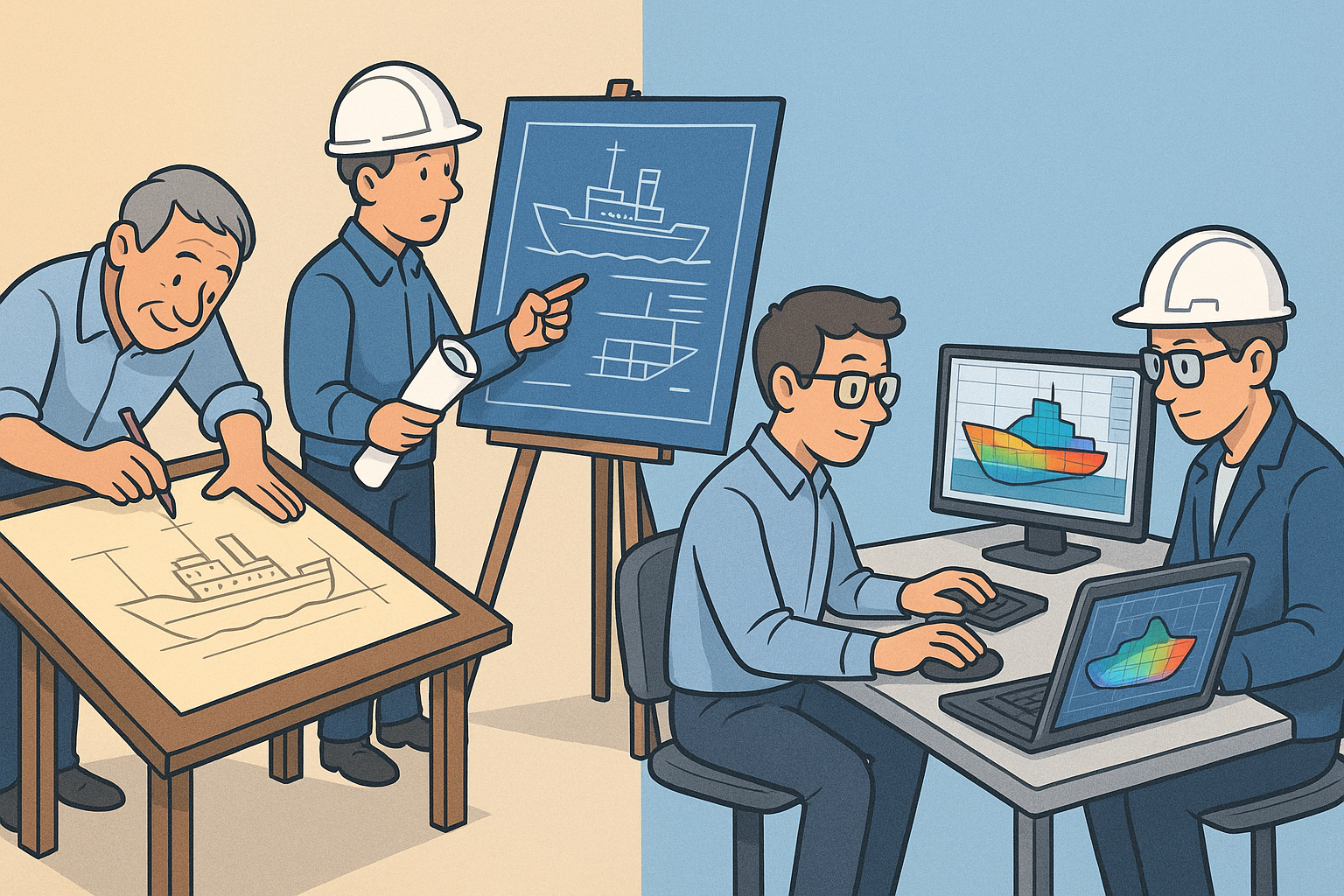Your Cart is Empty
Customer Testimonials
-
"Great customer service. The folks at Novedge were super helpful in navigating a somewhat complicated order including software upgrades and serial numbers in various stages of inactivity. They were friendly and helpful throughout the process.."
Ruben Ruckmark
"Quick & very helpful. We have been using Novedge for years and are very happy with their quick service when we need to make a purchase and excellent support resolving any issues."
Will Woodson
"Scott is the best. He reminds me about subscriptions dates, guides me in the correct direction for updates. He always responds promptly to me. He is literally the reason I continue to work with Novedge and will do so in the future."
Edward Mchugh
"Calvin Lok is “the man”. After my purchase of Sketchup 2021, he called me and provided step-by-step instructions to ease me through difficulties I was having with the setup of my new software."
Mike Borzage
Design Software History: Evolution of Marine Engineering Software: From Manual Drafting to Advanced Computational Design Technologies
October 21, 2025 7 min read


Introduction and Early Developments
The maritime industry has long been challenged by the complexity of its engineering problems. Throughout much of history, engineers in this field relied on manual drafting and extensive hand calculations to design safe and efficient vessels. In the early days, the process was largely based on empirical knowledge and coupled with trial and error, as shipbuilders worked with limited technological support. During the pre-digital era, the intricate curves of ship hulls and the dynamic forces generated by water interaction had to be managed through elaborate engineering drawings and physical scale models. As global maritime trade expanded, so did the need for more sophisticated design methodologies, and it became increasingly clear that traditional hand-drawn approaches could not adequately address the multifaceted challenges of modern ship design. Designed to support improved efficiency and reliability in the design process, early pioneers explored the potential of computer-based approaches to revolutionize the methodology used in marine engineering.
Historical Context and Manual Design Practices
In the decades preceding the digital revolution, marine engineers were tasked with the formidable responsibility of creating designs that could endure not only the mechanical and environmental stresses of the ocean but also the rigorous demands of regulatory bodies. Manual design practices were deeply rooted in art and science, becoming more cumbersome as the need for precision increased. Engineers applied detailed sketches, scale models, and a variety of rudimentary measurement techniques to address hull integrity and fluid dynamics, all while grappling with the inherent imprecision of human calculation. The significance of early design practices is underscored by the fact that many of these traditional methods still influence modern principles. These early days laid a robust foundation for contemporary computational methods by emphasizing creativity, rigorous testing, and iterative improvements in design. In addition, the maritime field’s early reliance on ingenuity and resourcefulness cultivated an innovative spirit that would later translate into the development of sophisticated software tools and **computer-aided design** methodologies.
Transition Toward Computer-Aided Approaches
As computing technologies began to emerge in the mid-20th century, a pivotal shift occurred in marine engineering. Early digital computers, though limited by today’s standards, began to provide engineers with the ability to simulate and optimize designs using rudimentary algorithms and numerical methods. This transition was catalyzed by the increasing demands of global trade and naval architecture, which required enhanced accuracy and efficiency. Several key technological milestones set the stage for the emergence of marine engineering software: the advent of mainframe computing, the application of finite element methods, and the integration of basic fluid dynamics models. These milestones fostered an environment where designers were able to move from predominantly manual processes to embracing a hybrid approach that merged classical methodologies with emerging digital tools. As a result, marine design software started evolving in functionality and scope, gradually replacing analog methods with automated techniques and increasingly precise algorithms, thus driving forward an era of digital transformation in maritime engineering.
Core Technological Innovations and Capabilities
The evolution of marine engineering software has been fundamentally driven by breakthroughs in computational methods and modeling techniques that are tailored to the specific challenges of maritime design. Early simulation tools were primarily concerned with basic hull design and rudimentary calculations of buoyancy, but they have since evolved into sophisticated platforms that integrate multiple engineering principles. A key aspect of this progress has been the incorporation of powerful finite element analysis (FEA) and computational fluid dynamics (CFD) algorithms. These technologies allow engineers to qualitatively and quantitatively assess water flow, pressure distribution, and structural integrity at unprecedented levels of accuracy. Engineers are now enabled to simulate various marine scenarios, predicting performance under a myriad of conditions, while the underlying algorithms continue to be refined and optimized through years of research and development. As a result, modern systems present a fusion of mathematical rigor and creative problem solving, positioning them at the forefront of engineering innovation.
Innovative Simulation Tools and Integrated Algorithms
Marine design software today benefits from robust simulation capabilities that have been honed specifically for maritime applications. The integration of mathematical models into these simulation tools has allowed designers to incorporate complex parametric variables into their designs. For example, in hull design, software systems not only factor in hydrostatic forces but also consider dynamic effects such as wave impact, resistance, and propulsion efficiency. Bulleted lists and diagrams are frequently used to elucidate the key components of the software’s computational approach:
- Finite Element Analysis (FEA): Used to calculate how structures respond to external forces, ensuring that the hull can withstand stresses.
- Computational Fluid Dynamics (CFD): Evaluates the interaction of water with vessel surfaces, crucial for optimizing hydrodynamic performance.
- Parametric Modeling: Allows for rapid iteration of design variations by systematically adjusting key variables.
Parametric and Mathematical Modeling in Maritime Software
In the context of marine engineering software, the integration of parametric design principles plays a pivotal role. Parametric models allow designers to define relationships between various design parameters. This ensures that as one parameter is altered, dependent variables adjust automatically in a consistent and predictable manner. The application goes well beyond aesthetic design; it is critical in optimizing hull shapes, load distribution, and the overall structural composition of a vessel. The importance of these models is epitomized by the fact that they dramatically diminish the margin for error by providing real-time feedback based on multiple simulated scenarios. The role of emerging technologies, such as CFD and FEA, in this space has also been crucial, as these computational methods provide the necessary framework to support the highly specialized needs of modern marine design. In summary, the layer of mathematical and parametric sophistication embedded in modern marine engineering software has revolutionized the field, making it possible for engineers to push the boundaries of design while maintaining rigorous safety and performance standards.
Industry Pioneers, Key Companies, and Influential Figures
Pioneering advances in marine engineering software have largely been driven by the efforts of dedicated companies, institutions, and individual engineers who not only recognized the needs of the maritime industry but also understood the immense potential for computer-aided design. Renowned organizations such as MARIN, Rolls-Royce Marine, and DNV GL have been at the forefront of innovation, consistently pushing the boundaries of what is achievable in marine design. These companies, with their deep-rooted expertise in both engineering and software development, have played a significant role in developing the tools now ubiquitous in the industry. Their efforts have paved the way for the integration of advanced simulation algorithms and for the evolution of design paradigms that once seemed impossible. The contributions of these organizations demonstrate how an interdisciplinary approach—melding engineering, computer science, and applied mathematics—can lead to breakthroughs that significantly enhance design accuracy and operational safety. The impact of these contributions is evident in today’s highly optimized vessels and offshore structures that are designed to meet strict regulatory and performance expectations.
Prominent Organizations and Their Role in Software Innovation
Among the key players, MARIN has been influential in the evolution of marine simulation tools. Their research and product development have encompassed not only hull designs but also the integration of environmental factors, improving the overall performance of ships. Rolls-Royce Marine has leveraged its expertise in propulsion and energetic systems to develop specialized software that assists in designing more fuel-efficient vessels. Additionally, DNV GL has contributed heavily to establishing standards that underpin safety protocols and operational guidelines across the global maritime industry. These organizations have taken advantage of the latest in digital transformation and technological synergy, providing engineers with powerful tools adapted to complex challenges. Their efforts are deeply embedded in the fabric of modern maritime engineering, ensuring that safety, efficiency, and environmental sustainability remain at the core of new designs.
Contributions of Influential Engineers and Software Experts
The transformation of marine design software has also been markedly influenced by the tireless work of individual engineers and software developers. These influential figures, whose names are frequently associated with breakthrough research and innovative design methodologies, have been central to advancing computer-aided design. They have not only contributed to refining simulation algorithms but also played an educational role by mentoring new generations in the principles of computational modeling and system optimization. Many of these thought leaders have published seminal research that underscores the integration of parametric design with finite element and fluid dynamic analysis. Their contributions have reverberated throughout the maritime sector, setting benchmarks for safety and performance. As a result, the legacy of these engineers continues to inform the development processes of modern marine software solutions, ensuring that the drive for innovation is maintained while achieving new heights in design precision and operational reliability.
Conclusion
The historical evolution of marine engineering software is a testament to the maritime industry’s remarkable capacity for innovation and adaptation. Over the decades, a combination of persistent research, technological advances, and practical demands has culminated in a suite of powerful digital tools that have reshaped the way ships and offshore structures are designed. This progression from traditional hand-drawn blueprints to today’s sophisticated simulations underscores the impressive strides made in applying computational power to solve complex engineering problems. The integration of **finite element analysis**, **computational fluid dynamics**, and parametric modeling has not only enhanced design accuracy but also significantly improved safety and operational efficiency, allowing for the creation of vessels that are more reliable and better adapted to modern maritime challenges.
Reflection on Technological Milestones and Industry Collaboration
As we reflect upon this evolution, it is clear that many of the foundational principles established during the early days of computer-aided design continue to resonate in modern applications. Key technological milestones, such as the introduction of mainframe computing, the formal adoption of FEA in the maritime context, and the pioneering use of CFD simulations, have collectively contributed to a landscape where systematic innovation drives progress. Moreover, collaborative efforts between industry giants, research institutions, and dedicated engineers have cemented a legacy of ingenuity and progress. This synergy between technological advancements and robust engineering practices has allowed marine software solutions to meet the rigorous safety, efficiency, and regulatory standards demanded in today’s global market. The enduring influence of these early innovations remains evident in every modern design tool employed in the maritime industry.
Future Trends and the Ongoing Evolution of Marine Engineering Software
Looking ahead, the future of marine engineering software promises further transformative developments. One anticipated direction is the integration of digital twin technology, which will enable real-time, dynamic modeling of vessels and operating environments. Such advances hold the potential to revolutionize predictive maintenance, risk assessment, and operational efficiency by tightly pairing virtual models with physical systems. In addition, emerging trends in sustainable design practices are prompting the development of software tools that can simulate not only performance metrics but also environmental impact factors, paving the way for greener maritime technology. Digital innovation continues to propel the field forward, ensuring that marine design remains at the cutting edge of safety, efficiency, and adaptability. As collaborative efforts between academia, industry, and software developers intensify, the possibilities for enhancing marine design methodologies are virtually limitless, firmly establishing marine engineering software as an indispensable pillar of modern maritime innovation.
Also in Design News

Rhino 3D Tip: Optimizing Design Visualization with Section Tools in Rhino 3D
October 21, 2025 3 min read
Read More
Empowering Design Innovation: The Role of Custom Scripting in Modern Software
October 21, 2025 10 min read
Read More
Cinema 4D Tip: Optimizing Texturing Techniques in Cinema 4D for Realistic Surfaces
October 21, 2025 2 min read
Read MoreSubscribe
Sign up to get the latest on sales, new releases and more …


